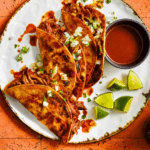What Are the Main Ingredients in Birria? The Ultimate Guide to This Iconic Mexican Dish
What Are the Main Ingredients in Birria? Birria has taken the culinary world by storm, captivating food enthusiasts with its rich, savory flavors and versatility. From traditional Mexican households to trendy food trucks serving birria tacos with consommé for dipping, birria is enjoying its much-deserved spotlight.
But what exactly goes into making this delicious dish? What are the main ingredients in birria? This comprehensive guide breaks down everything you need to know about the key ingredients, regional variations, cooking techniques, and more.
Table of Contents
- What is Birria?
- A Brief History of Birria
- What Are the Main Ingredients in Birria?
- 3.1. Protein: Goat, Beef, Lamb, or More?
- 3.2. The Essential Chiles
- 3.3. Aromatic Spices
- 3.4. Acidic Components
- 3.5. Other Flavor Enhancers
- Optional Ingredients and Variations
- How to Prepare Birria: An Overview
- The Role of Consommé
- Different Types of Birria: Tacos, Quesabirria, and More
- Tips for Making the Best Birria at Home
- FAQ: What Are the Main Ingredients in Birria?
- Final Thoughts
1. What is Birria?
Birria is a traditional Mexican dish that originated in the state of Jalisco, particularly in the town of Cocula, near Guadalajara. Traditionally made with goat meat, birria is known for its deep, complex flavors developed through marination and slow cooking. The dish is typically served as a stew with consommé (a spiced broth) or incorporated into tacos, often with melted cheese.
2. A Brief History of Birria
Birria dates back to the colonial period when Spanish settlers introduced livestock such as goats to Mexico. Goats quickly became overpopulated, and their meat was considered tough and gamey. Local cooks developed birria as a way to marinate, tenderize, and mask the strong flavor of goat meat, creating a dish that transformed a culinary challenge into a beloved tradition.
Over time, birria evolved, with various regions adopting their own versions. Today, birria is made with different proteins such as beef and lamb, broadening its appeal globally.
3. What Are the Main Ingredients in Birria?
At its core, birria’s signature flavor profile comes from the combination of meat, dried chiles, aromatic spices, acid, and a slow cooking process that melds everything together. Let’s break down each component in detail.
3.1. Protein: Goat, Beef, Lamb, or More?
Traditionally, birria was made with goat meat (chivo), prized for its lean texture and slightly gamey flavor. However, as birria spread beyond its regional origins, cooks began using other meats that are more widely available:
- Goat (Chivo): The classic and most authentic choice.
- Beef (Res): Commonly used in birria de res, particularly cuts like chuck roast, short ribs, or brisket, which offer marbling and tenderness.
- Lamb (Borrego): Another traditional alternative, often used for its robust flavor.
- Pork (Cerdo): Less common, but some modern recipes incorporate pork shoulder for a unique twist.
Key Takeaway: The protein sets the foundation of birria’s flavor. Tough, collagen-rich cuts that benefit from long cooking times are ideal.
3.2. The Essential Chiles
Birria’s deep red hue and smoky, earthy flavor come from a combination of dried chiles. These are typically toasted, soaked, and blended into a marinade.
The most common chiles include:
- Guajillo Chiles: Mild heat, with a fruity and slightly tangy flavor.
- Ancho Chiles: Dried poblano peppers that offer mild heat with sweet and smoky notes.
- Pasilla Chiles: A bit spicier, with rich, earthy undertones.
- Chilies de Árbol (Optional): For those who want extra heat, these small but potent chiles are added.
Each cook may adjust the blend according to their heat preference and desired complexity.
Pro Tip: Always deseed and devein dried chiles to reduce bitterness.
3.3. Aromatic Spices
Spices are essential to birria’s layered flavor. The most common spices include:
- Cumin: Earthy and slightly nutty.
- Cinnamon (Canela): Adds warmth and a hint of sweetness.
- Cloves: A pungent spice that provides depth.
- Black Pepper: For mild heat.
- Bay Leaves: Herbal and slightly floral.
- Thyme and Oregano: Herbal notes, especially Mexican oregano, which has a more citrusy, robust flavor than Mediterranean oregano.
These spices, combined with the chiles, create birria’s characteristic complexity.
3.4. Acidic Components
Acidity is crucial to balance the richness of the meat and fat.
Common acids used in birria include:
- Vinegar: Most commonly white vinegar or apple cider vinegar.
- Citrus Juice: Lime or orange juice, for brightness.
- Tomatoes: Sometimes included in the marinade or sauce, providing subtle acidity and body.
These components also help tenderize the meat during marination.
3.5. Other Flavor Enhancers
Beyond meat, chiles, spices, and acid, a few additional ingredients round out the flavor:
- Garlic: Typically used in generous amounts.
- Onions: Often blended into the marinade or cooked alongside the meat.
- Salt: Essential for enhancing all other flavors.
- Lard or Oil: Used for searing the meat and occasionally enriching the consommé.
4. Optional Ingredients and Variations
While the above components form the core of traditional birria, several optional ingredients and techniques reflect personal or regional preferences:
- Chocolate: Some recipes include a small amount of Mexican chocolate for depth.
- Ginger: Occasionally added for a unique aromatic note.
- Beer or Broth: Some cooks use beer or beef broth to braise the meat for extra flavor.
- Fresh Herbs: Like cilantro or epazote, sometimes added at the end.
5. How to Prepare Birria: An Overview
Step 1: Prepare the Marinade
- Toast the dried chiles to release their oils.
- Soak chiles in hot water to soften.
- Blend chiles with spices, garlic, onion, acid, and sometimes tomatoes, creating a rich adobo.
Step 2: Marinate the Meat
- Coat the meat thoroughly with the marinade.
- Refrigerate for several hours, preferably overnight.
Step 3: Cook the Birria
- Braise the marinated meat in a sealed pot, either in the oven, on the stovetop, or in a slow cooker, until fork-tender.
- The juices from the meat and marinade form the consommé.
Step 4: Serve
- Traditionally served as a stew with consommé.
- Modern popular variations include birria tacos or quesabirria — tacos with melted cheese and a side of consommé for dipping.
6. The Role of Consommé
The consommé is the rich, spiced broth produced from slow-cooking the meat with its marinade. It’s not just a byproduct but a key part of the dish, used for:
- Dipping birria tacos.
- Serving alongside the meat.
- Adding moisture and extra flavor.
Many birria lovers argue that the consommé is the best part!
7. Different Types of Birria: Tacos, Quesabirria, and More
While birria was traditionally served as a stew, its modern rise to fame is thanks to:
- Birria Tacos: Corn tortillas filled with birria meat, often dipped in consommé before being griddled.
- Quesabirria: Birria tacos with cheese, creating a crispy, melty, savory experience.
- Birria Ramen: A fusion dish combining birria consommé and meat with ramen noodles.
- Birria Pizza: Another modern take, layering birria meat and cheese on pizza dough.
Each variation maintains the essence of birria — the rich, spiced meat and consommé.
8. Tips for Making the Best Birria at Home
- Use quality meat: Opt for well-marbled cuts.
- Marinate overnight: This ensures maximum flavor absorption.
- Low and slow cooking: Essential for tender meat and a developed consommé.
- Toast your spices and chiles: This unlocks deeper flavors.
- Skim fat carefully: Some prefer to reserve the fat for griddling birria tacos.
9. FAQ: What Are the Main Ingredients in Birria?
What meat is traditionally used in birria?
Goat meat is traditional, but beef (especially chuck roast or short ribs) and lamb are also commonly used today.
What chiles are essential for birria?
Guajillo, ancho, and pasilla chiles are the most commonly used. Some recipes add chile de árbol for heat.
Is vinegar necessary in birria?
Yes, vinegar or another acidic ingredient is key to balancing flavors and tenderizing the meat.
Can I make birria without dried chiles?
While possible, it’s not recommended. Dried chiles provide the signature smoky, earthy flavors and vibrant color.
What spices go into birria?
Typical spices include cumin, cinnamon, cloves, black pepper, and bay leaves, along with herbs like thyme and Mexican oregano.
Is birria always served as tacos?
No. Traditionally, birria is a stew served with consommé. However, birria tacos and quesabirria are popular modern variations.
What is consommé in birria?
It’s the flavorful broth created during the braising process, often served alongside or used for dipping birria tacos.
Can I use a slow cooker for birria?
Yes! Slow cookers are a great option for preparing birria at home, allowing for low and slow cooking without much oversight.
10. Final Thoughts
Understanding what the main ingredients in birria are helps appreciate the dish’s incredible complexity and cultural significance. From the carefully chosen blend of dried chiles to the slow-cooked protein, every component plays an essential role in creating birria’s iconic flavor.
Whether you’re enjoying birria in a traditional Mexican setting, at a trendy taco stand, or making it at home, knowing the key ingredients and techniques will deepen your appreciation for this remarkable dish.
So next time you dip a crispy birria taco into that velvety consommé, you’ll know exactly what makes it so irresistible!
🌮 Ready to Try Birria?
If you’ve never made birria at home, now is the perfect time to gather these essential ingredients and experience this legendary dish for yourself.
Happy cooking!
📌 Don’t Forget to Bookmark This Guide!
For more culinary deep dives and authentic Mexican recipes, stay tuned to our blog. If you enjoyed this article, share it with your foodie friends and leave us a comment below!
Meta Description: Discover what the main ingredients in birria are, from essential meats and dried chiles to spices and acids. Learn about traditional methods, modern variations, and get answers to all your birria questions in this ultimate guide!




